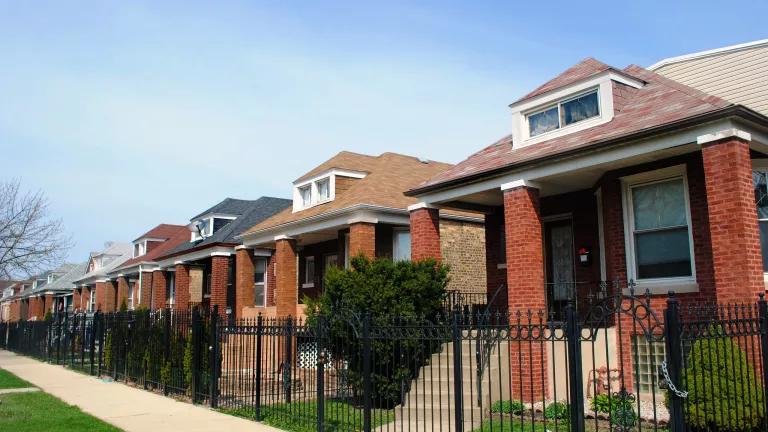
Timothy Schenck
There’s a shocking global statistic that we may be on the cusp of changing for good.
Here it is: If U.S. buildings were a country, they would be the third largest energy consumer in the world.
That may be surprising because we concentrate a lot on carbon reduction in energy production and transportation—the other big sources of the dangerous gases that trap heat and make the planet’s climate less stable. But with the news today that the Urban Land Institute (ULI) is carrying on the mantle of the Tenant Energy Optimization Program, we are entering a new and important era of taming the waste in energy generated by big commercial buildings and helping to clean our air, bolster bottom lines, and improve health and well-being for millions of workers.
The announcement is the culmination of almost seven years of work stemming from a brainstorming session at NRDC’s Center for Market Innovation, now a part of the Urban Solutions program, where we, along with partners Johnson Controls Inc., Jones Lang LaSalle, and Goldman Sachs, set out to identify ways to substantially increase implementation of energy efficiency within commercial buildings by working with the biggest energy users in a building—corporate tenants.
And there was impetus for change. None other than the Empire State Building – perhaps the best-known commercial building in the country—had recently completed a deep retrofit of its base operating systems in 2009, seeing substantial energy savings and a payback in under five years. But saving energy overall in a building’s operation is one thing, and getting the companies that move in to take up that mission is another.
That’s where tenant energy performance comes in. Tenants are typically at least half the equation in terms of energy use in big buildings, and that’s how the tenants in the Empire State Building and now many other companies and entities—including LinkedIn, Shutterstock, Bloomberg LP, The Estee Lauder Companies, Cushman and Wakefield and Reed Smith—through a demonstration project launched by NRDC and its partners, began to incorporate and build on this blueprint for saving energy.
“As we see it, the buildings are the supporting backbone of the energy-saving structure, while the tenants are the meat and muscle that push the savings over the finish line,” says Shelley Poticha, director of Urban Solutions. “We want to help support corporate tenants in achieving energy cost savings and get them engaged in this effort on a national scale. We transferred this initiative to ULI because they have such deep real estate expertise and a built-in national network.”
In CMI’s work on conceptualizing, piloting, and incubating the model, we focused on 10 tenant projects to identify the best ways to work with companies via architects, mechanical engineers, tenant representatives and others throughout the lease process to help optimize energy performance in a cost-effective way, from selecting space in a high performing building to incorporating use of the most energy efficient lighting, HVAC and other systems in the design process.
The idea is that small incremental costs toward energy efficiency in the beginning of the tenant build-out, when companies move into new office space or remodel after renewing a lease, will mean bigger savings on that investment over time as the tenants see lower energy bills. The pilots helped capture what the process can look like, building tools and replicable protocols and showing that companies can achieve a 30 to 50 percent energy savings over what is required in most building energy codes, with a 3-5 year payback and an annual internal rate of return (IRR) of 25 percent.
We are excited to see ULI bringing this work to scale, which is where things get even more exciting. The 10 pilot projects saved the companies $3.5 million and demonstrated that when incorporated into the “business as usual” commercial leasing process, it is not a burden to make energy efficiency improvements, but rather a boon. Transforming commercial buildings from the inside out can help us make incremental but important changes to our national building stock and help cities across the country tackle their biggest source of emissions.
Because the energy used to heat, cool, and power buildings can contribute as much as 50-80 percent of greenhouse gas emissions in cities, NRDC is committed to scaling energy improvements in buildings. We continue do so through our City Energy Project in partnership with the Institute for Market Transformation, where we work with cities to help them with locally tailored approaches to saving energy in big buildings and with becoming leaders in sustainability.
Recognizing the ongoing progress in CEP's first 10 cities, its funders reinvested in the project with a new round of funding announced at COP21 in Paris a year ago, reinforcing that saving energy in big buildings is a key step in getting to the goals set in Paris and recently adopted worldwide. This funding will help the project expand to reach even more cities and building owners, as well as tenants.
Durable change happens when the most environmentally preferable and economically sound decisions are the easiest, leading to a new, sustainable business-as-usual. That’s what improving energy efficiency in some of our biggest energy wasters—large buildings—accomplishes.
The work fits, too, with a growing industry emphasis on corporate responsibility.
In 2011, just 20 percent of Fortune 500 businesses published sustainability reports. Last year, it was 81 percent. There is more of a corporate and business focus on sustainability because it makes business sense. And this is one of those solutions that is good for business and good for the environment.
Because tenant spaces are such a big part of the equation, the ULI Tenant Energy Optimization Program will be a useful tool in helping cities achieve their energy savings goals by providing businesses with a proven strategy for achieving cost-effective energy savings. We are thrilled to see the Tenant Energy Optimization Program continuing to make it easier for companies to prioritize high performance office space as the best solution for their business.



